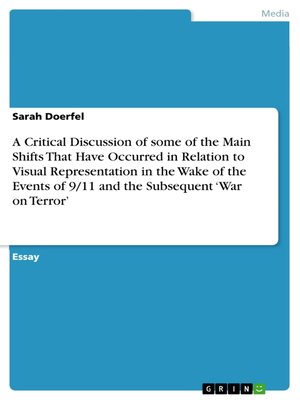A Critical Discussion of some of the Main Shifts That Have Occurred in Relation to Visual Representation in the Wake of the Events of 9/11 and the Subsequent 'War on Terror'
ebook
By Sarah Doerfel

Sign up to save your library
With an OverDrive account, you can save your favorite libraries for at-a-glance information about availability. Find out more about OverDrive accounts.
Find this title in Libby, the library reading app by OverDrive.



Search for a digital library with this title
Title found at these libraries:
| Loading... |
Essay from the year 2010 in the subject Art - Photography and Film, grade: 61, University of Westminster (Media, Arts and Design), course: Photography and Visual Culture , language: English, abstract: The events of 9/11 shocked people all over the world and as a political consequence the 'war on terror' was established. A 'public trauma' emerged after the unexpected attacks because they made clear how near the unknown but also continuing threat of terrorism is. An extraordinary situation took place when people world wide felt shocked and directly targeted by the attacks. The exploding demand on visual media which dealt with the issue was the expression of a new function in the wake of the events: Visual representation had to assume the responsibility of substituting for the essential act of 'bearing witness' to help the public with handling trauma and grief (Zelizer, 2002).
Fighting a war against an unknown enemy – 'the terror' or 'the evil' – was a historically unprecedented situation. People were frightened and many wanted to find somebody to blame for the attacks to feel safe again; the reaction of the government to attack Afghanistan found support although the justification for the attacks would be proven wrong later. But the dimension of cruelty of this war and in the American prison Abu Ghraib towards alleged terrorists caused another public shock after the limited imagery was published.
Together, these two events and their subsequent public traumas caused two very contrasting consecutive world wide moods towards the US government. In retrospect the events are said to mark a change within visual representation, particularly the representation of trauma.
One of the main shifts in visual representation in the wake of these crises was that the focus moved towards the public. "This was curious, for among photojournalists the idea of using images to draw from and upon the public rather than to depict the events being witnessed was antithetical to what good journalism is supposed to do" (Zelizer, 2002, p.48).






